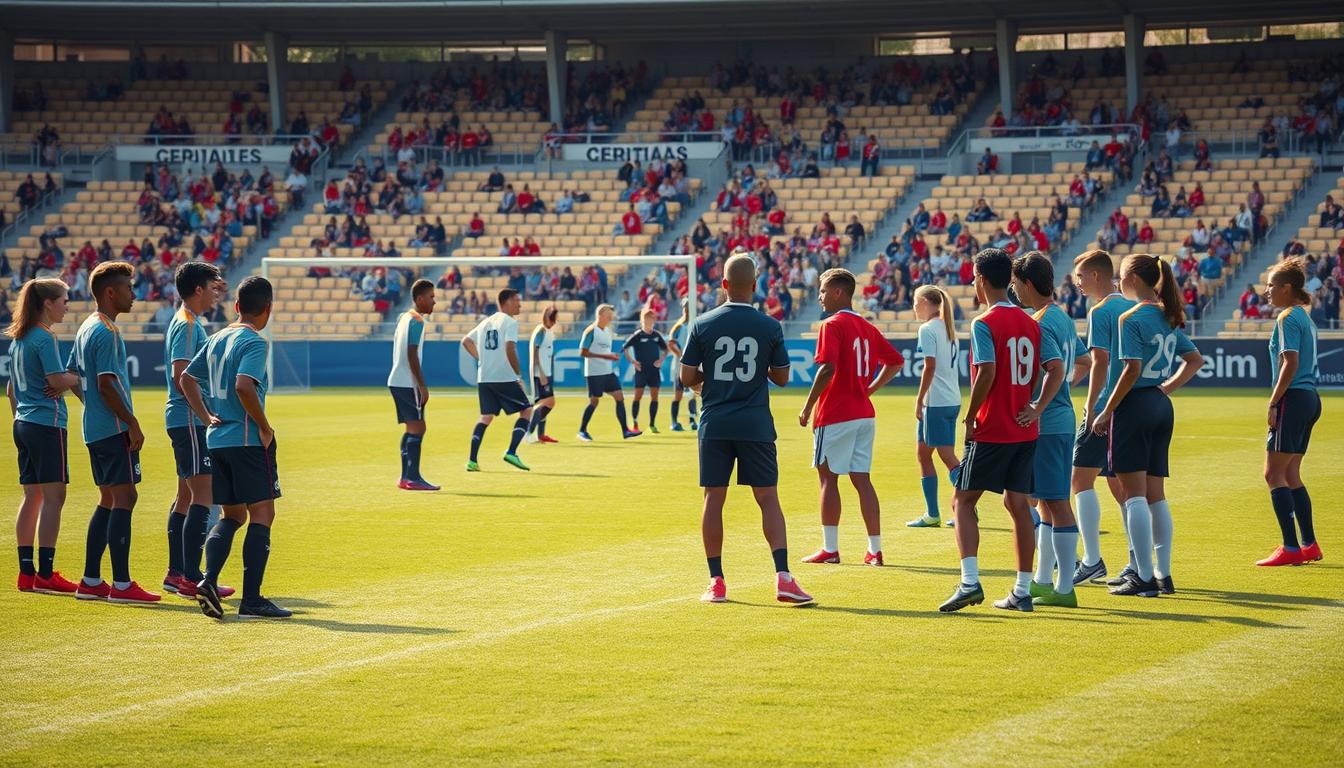Leadership Activities for Soccer Teams

Ever wondered what separates good squads from legendary ones? It’s not just skill—it’s how leaders step up when it matters most. Strong guidance on the field shapes morale, sharpens performance, and builds resilience during tough moments. Whether you’re preparing for a championship or rebuilding after a loss, the right strategies can turn a group of individuals into an unstoppable force.
Great captains and coaches don’t just give orders—they inspire trust and foster unity. Their actions set the tone for how others respond to pressure, celebrate wins, and recover from setbacks. When everyone shares responsibility, you create a culture where players push each other to excel, both in practice and critical games.
Key Takeaways
- Leaders directly impact group confidence and adaptability during challenges.
- Shared responsibility creates stronger bonds than relying on one person.
- Visible effort from role models motivates others to raise their standards.
- Consistent guidance improves decision-making in high-pressure situations.
- Investing in multiple leaders ensures long-term growth and flexibility.
Understanding the Role of Leadership in Soccer
True leadership on the pitch isn’t about titles—it’s about action when it counts. While captains and coaches have formal roles, every player can influence outcomes by making smart choices during high-stakes moments. Trust forms when individuals consistently back their words with effort, whether tracking back defensively or encouraging others after a missed opportunity.
Great squads thrive because members prioritize collective goals over personal stats. This means celebrating assists as much as goals or covering for a teammate’s positioning error without complaint. Unity grows when everyone feels their contribution matters equally.
| Role Focus | Decision-Making | Visibility | Impact |
|---|---|---|---|
| Traditional (Captain/Coach) | Pre-planned strategies | Centralized authority | Predictable outcomes |
| Dynamic (Players) | In-game adaptability | Distributed influence | Flexible responses |
Different scenarios demand varied strengths. A defender might organize the backline during counterattacks, while a forward sparks urgency when trailing. This fluid approach ensures the group always has someone ready to guide through their expertise.
Soccer team leadership activities: Empowering Your Players
Empowering athletes starts with trust and clarity. When they know their role matters, they’ll step up without hesitation. Your job? Create opportunities for them to shine in low-stakes scenarios before the big match.
Building Confidence on the Field
Start with drills that mirror real-game decisions. For example, run 3v3 mini-matches where each person rotates as captain. They’ll practice directing plays and adjusting tactics mid-drill. Success here builds belief in their ability to lead under stress.
Gradually increase complexity. Add time limits or uneven player numbers to simulate pressure. Praise specific actions like quick recoveries or smart passes—this reinforces what “good leadership” looks like tangibly.
Communicating What Is Expected
Use visual aids during training. A whiteboard with position-specific responsibilities helps players see their impact. For defenders, highlight organizing the backline. For forwards, emphasize creating scoring chances through movement.
Give immediate feedback. Instead of saying “good job,” try: “Your decision to switch play opened up their defense.” This ties actions to outcomes, making expectations concrete. When everyone knows their job, they’ll hold themselves—and others—accountable naturally.
Developing Leadership Skills Through On-Field Practice
Building strong leaders starts where growth happens most—during practice. Structured drills and challenges let individuals test their decision-making while coaches identify natural problem-solvers. The goal? Create environments where players learn to guide others through action, not just words.
Self-Discovery with Team Drills
Try a 4v4 scrimmage where roles rotate every three minutes. Players must negotiate tactics like pressing high or holding shape. Without constant instructions, they’ll start organizing themselves—revealing who steps up to adjust formations or motivate peers.
Add constraints to deepen learning. For example, limit touches to two per player. This forces quick thinking and clearer communication. Those who thrive here often excel at balancing group needs with personal instincts.
Setting Game Challenges for Growth
Design scenarios that mirror real-match pressure. A 3v5 underload drill, where the smaller group defends a lead, pushes them to strategize under fatigue. Leaders emerge by directing positioning and maintaining focus despite the odds.
| Drill Type | Focus | Outcome |
|---|---|---|
| 4v4 Rotating Roles | Tactical Adaptability | Identifies proactive communicators |
| 3v5 Underload | Resilience Under Pressure | Highlights calm decision-makers |
| Position-Specific Scrimmage | Role Mastery | Builds confidence in expertise |
Gradually increase difficulty by adding time limits or silent periods (no verbal cues). Players learn to read body language and anticipate moves—a key trait for guiding others mid-game.
Leading by Example and Staying Calm Under Pressure
What separates a good leader from a great one? Actions speak louder than titles. When you consistently demonstrate the effort and attitude you expect, others follow naturally—especially during crunch time in tight game situations.

Start small. Arrive early to warm-ups. Celebrate every save or interception like it’s a goal. These habits build trust and show teammates what “giving your all” looks like daily.
Maintaining a Positive Attitude
Mistakes happen. How you react defines the group’s mood. After a missed penalty, high-five the player and say, “Next one’s yours.” This shifts focus from failure to opportunity.
Practice positive triggers. During drills, shout encouragement like “Great recovery!” instead of criticizing errors. Smiles spread faster than frustration.
Modeling Steady Decisions During the Game
Pressure amplifies emotions. Train for chaos with “silent quarter” scrimmages where only hand signals are allowed. This sharpens non-verbal communication and forces calm problem-solving.
When trailing late, slow down. Walk to take a throw-in. Make deliberate eye contact with teammates. Controlled body language tells everyone, “We’ve got time.”
Role-play tough situations in practice. For example: “Down 2-1 with 5 minutes left—how do we adjust?” Let player leaders propose solutions. They’ll carry that confidence into real game moments.
Effective Communication and Feedback Strategies
Clear talk wins games. The best squads thrive when everyone feels heard—whether they’re suggesting a new formation or admitting they’re struggling. Your job? Build systems that let teammates share ideas freely while giving feedback that lifts instead of deflates.
Creating Open Dialogue with Teammates
Start with weekly check-ins. Ask each group member one question: “What’s working?” and “What needs fixing?” Write answers anonymously on a board. This removes fear of judgment and surfaces honest insights.
Rotate discussion leaders during meetings. Let defenders lead tactical talks one week, forwards the next. When people guide conversations, they invest more in solutions.
Offering Clear and Simple Feedback
Use the “Fix-It Sandwich”: Compliment → Correction → Encouragement. Example: “Your positioning was perfect → Pass sooner next time → You’ll dominate that flank!” This way, critiques feel like upgrades, not attacks.
Simplify complex plays with visuals. Draw passing lanes on a tablet using arrows instead of jargon. When coaches show instead of tell, players grasp concepts faster.
| Do This | Not That |
|---|---|
| “Adjust your angle when defending crosses” | “You’re bad at headers” |
| “Let’s try overlapping runs on the right” | “Our right side is weak” |
The Role of Coaches in Developing Team Leaders
Great squads don’t just happen—they’re built by mentors who know when to lead and when to let others take charge. Your ability to shape players into confident decision-makers determines whether your group thrives under pressure or crumbles when it matters most.
Establishing a Clear Training Vision
Start every season by defining your squad’s identity. Use drills that mirror your style—like possession-focused rondos for a high-pressing team or counterattack simulations for fast-break specialists. This creates consistency in how players approach challenges.
Give bite-sized feedback during practice. Instead of saying “Defend better,” try: “Close the gap between you and the winger.” Specific instructions help leaders understand exactly what excellence looks like in their role.
| Approach | Focus | Outcome |
|---|---|---|
| Structured Sessions | Repetition of core skills | Builds muscle memory |
| Flexible Scenarios | Adaptive problem-solving | Develops creative thinkers |
Balancing Guidance with Player Independence
Let your squad make mistakes in practice. When running set-piece drills, allow them to experiment with formations before stepping in. This builds confidence in their skills while showing you trust their judgment.
Gradually increase responsibility. Assign rotating captains to lead warm-ups or debrief sessions. Watch who naturally organizes drills or lifts spirits after tough losses—these are your emerging leaders.
Create “decision zones” during scrimmages. Designate areas where only players can call plays, not coaches. They’ll learn to trust their instincts while staying aligned with the team’s strategy.
Practical Tips for Aspiring Soccer Leaders
Great playmakers don’t just react—they shape the game before it unfolds. Your choices with the ball can either spark opportunities or stall momentum. Let’s break down how to make every touch count.
Improving Decision Making on the Field
Scan the field three steps before receiving the ball. Notice where defenders cluster and where space opens. This gives you extra seconds to choose between passing, dribbling, or shooting.
Practice 2-touch games where you must release the ball quickly. These drills sharpen your ability to read angles and anticipate movements. You’ll learn to trust your instincts under pressure.
Supporting Teammates Through Smart Passing
Pass to feet when they’re set up—pass to space when they’re moving. Watch how players receive the ball during fun drills and adjust your delivery accordingly. Slower, accurate passes often work better than rushed ones.
Master the “look-away” pass. Glance toward one area while sending the ball elsewhere. This simple trick creates confusion in defenders and gives receivers extra time to control play.
Remember: Great decisions come from knowing your group’s strengths. If a wing player struggles with headers, serve ground crosses instead. Match your skills to theirs, and watch the whole game elevate.
Wrapping Up Your Journey to Leadership Success
Leadership excellence isn’t born overnight—it’s forged through consistent, intentional actions. By empowering players to step up in small moments, you create a team culture where everyone contributes to shared goals. Remember, great leaders don’t just direct—they listen, adapt, and elevate those around them.
Start today with three actionable steps: host daily 5-minute check-ins to discuss challenges, rotate captains during drills to uncover hidden strengths, and review game footage to celebrate smart decisions. These ways of reinforcing leadership skills build habits that last beyond the season.
Your role extends beyond wins and losses. It’s about creating a legacy where every member feels valued and capable of guiding others through tough situations. With time and consistent effort, your group will develop the resilience to thrive when pressure mounts.
Now go lead—not just with words, but through the quiet confidence that turns good squads into unforgettable ones.
